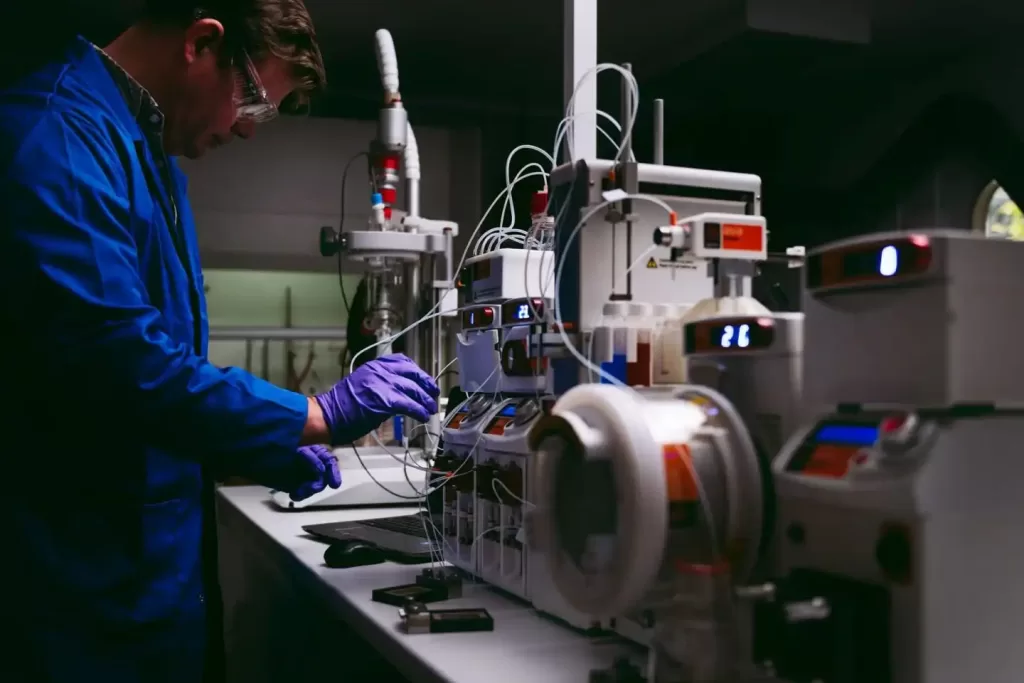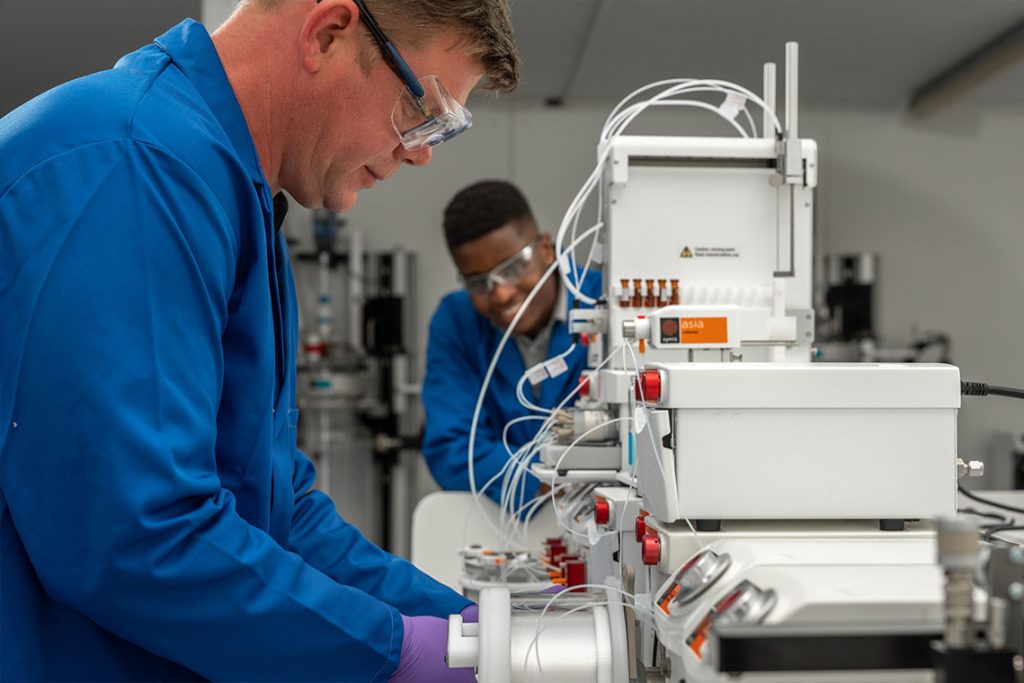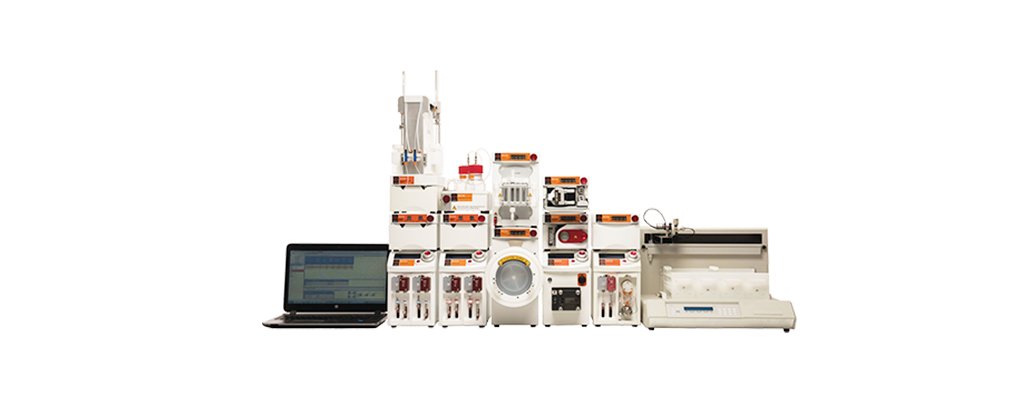Automated Flow Chemistry
Using Automated Flow Chemistry in Compound Library Generation
The impact of Flow chemistry has seen this enabling technology being applied to a growing number of applications over the years in modern laboratories. Its use in the generation of libraries of compounds for screening against a biological target has seen the adoption of AI being applied in the early drug discovery process to enable the faster exploration to find potential drug candidates. The automated continuous flow chemistry system from Syrris has allowed chemists to fully take advantage of this application.
The use of flow synthesis has many benefits over traditional batch protocols when applied to library generation. Flow chemistry increases the scope of reactions that can be performed, even when using automated batch processes, and the ability to telescope several operations together enables a more efficient process. The overall improved reproducibility and cost compared to the equivalent manual synthesis has helped to increase its use in this application.

Traditional Batch Methods
Organic chemistry is dominated by batch processes in which reactions are carried out in round-bottomed flasks or batch reactors. These reactors are mainstays, partly due to the overall complexity of the synthesis being carried out. Automation has helped the development of parallel and combinatorial library generation with the miniaturization of reactions using liquid handlers and automated purification.
However, library synthesis through these techniques is limited as reaction scales are decreased. The scope of chemistry available often delivers low yielding and unreliable, low-reproducibility reactions requiring extensive re-optimization during subsequent resynthesis and scale-up.
The time-consuming purification needed after each reaction step wastes resources and delays the delivery of the final compounds. A significant time delay may occur from the design hypothesis to obtaining the results, thus limiting the number of compounds that can be advanced into clinical studies. This has a huge impact on the timelines and success rates of the drug discovery process.
Flow Chemistry Methods for Library Generation
Automated flow chemistry platforms are becoming increasingly utilized in the drug discovery process for library generation. Flow chemistry enables an increase in the range of chemistry suitable for automation, improves efficiency, safety, and environmental impact as well as increasing the available chemical space.
Automated flow synthesis systems enable researchers to perform chemistries in series and integrate with downstream processes reducing work-up and isolation steps. It offers a direct route to scaling hit- or lead-compounds with no re-optimization necessary. We can synthesis exploratory compounds on a small scale for screening and resynthesis larger amounts using the same methodology.
A flow synthesis approach to library generation can show a reduction of both cost and time and is valid for fast optimization and the preparation of diverse compound series to provide valuable information in the early stages of drug discovery programs. These platforms can couple synthesis with in-line analysis and bioassays creating platforms capable of shortening the medicinal chemistry discovery process further.1,2
Automating Flow Synthesis
The ability to automate any chemical process allows to not only free chemists to perform more tasks but to increase the performance and control of those chemical processes. Automation can give precise control of reagent additions, mixing rates, temperature, and pressure control and more while recording and logging data.
One of the advantages of performing this technique is the ability to fully automate a flow based approach to experiments with increasing complexity. Using modular flow chemistry systems, like the Asia Flow Chemistry System, chemists can control a range of modules to perform multiple operations in a continuous process. Modular flow chemistry platforms can combine and control not only flow reactors which can be heated or cooled but access previously restricted or underused activation methods such as photochemistry and electrochemistry.
We can also couple flow reactors with methods to facilitate continuous in-line purification (with the Asia FLLEX) and in-line analysis (with the Asia SAD) to not only synthesize exploratory compounds but work-up and identify what’s been made. We can employ these techniques at any step in the reaction sequence to increase our capabilities further.
It is possible with the right method development to combine any or all these techniques to synthesis molecules over multiple reaction steps in a truly continuous process.
Flow Automation for Reaction Optimization
Using automated experimentation chemists can rapidly optimize reaction conditions and evaluate novel methodology. As with any experiment we use our knowledge to design the correct synthetic route to the molecules we want to make. In a flow process we also have to select which modules we require to perform the unit operations to match the synthesis. We then prepare the reagents and experimental set-up. Once we have this in place, we can use run a series of experiments to explore a full range of reaction parameters.1
We can screen continuous parameters such as residence time, reaction stoichiometry, reaction temperature and pressure. With the addition of automated reagent injectors (such as the Asia Automated Reagent Injector) we can even explore discontinuous reaction parameters such as reagent, catalyst or enzyme screening.
With the correct control software, we can even import files from Design of Experiment (DoE) software to make the process even more efficient.
Once we have identified the optimum reaction conditions for our process, we can apply this directly to synthesis a library of compounds or use the same conditions to process a larger quantity of material.
The modular nature of The Asia product range allows chemists to set-up any flow chemistry application. For reaction optimization applications the suggested module layout of the Asia Process Optimzation Flow Chemistry System allows access to this process.
We can add structure diversity in many ways when building molecules, by using diverse starting materials, adding diversity into core structural motifs in multicomponent reactions, adding diversity in the synthesis of uncommon, low diversity starting material sub-sets and creating diversity from convergent synthesis.
As when using automated flow platforms for reaction optimization and method development we can use the same automated, modular processes to make arrays of compounds. We first design the correct synthetic route to the molecules we wish to make; this includes the selection of modules we require to perform the unit operations to match the synthesis. We then prepare the reagents and experimental conditions. Once we have this in place, we can use run a series of experiments using the techniques above to create the diversity in structure we want to explore. If we’ve optimized the conditions on the same platform, then most of our job is already done as we can use the same fully automated flow based approach.
Typically, when generating libraries of compounds, we will use the same reaction conditions but when automating a flow process, we can tailor this to the relative reactivities of the starting materials we’ve selected, adding even more control to the success of our synthesis.
The use of reagent addition with automated reagent injectors, such as the Asia Automated Reagent Injector and collection modules linked with control software allows the synthesis of as many compounds in an automated experiment as we have vials to collect them into.
The modular nature of The Asia product range allows chemists to set-up any flow chemistry application. For library generation applications the suggested module layout of the Asia Discovery Flow Chemistry System allows access to this process.
Closed Loop Optimization and Machine Learning For Chemistry Platform
Synthetic platforms have been demonstrated with the integration of machine learning with flow synthesis coupled with real-time screening. These platforms have been shown to be highly effective in optimizing reaction methodology and conditions.
Machine learning platforms are still mainly in the academic arena but are actively being pursued by the chemical and pharma industries to enhance their capabilities. Academic groups such as Prof. Richard Bourne (Univ. of Leeds, IPRD), Prof. Steve Ley (Univ. of Cambridge), and Prof. Alexie Lapkin (Univ. of Cambridge, iDMT) are all actively exploring methods to integrate digital technologies with synthetic processes for the automation, optimization, and development of pharmaceuticals.
With the move towards more industry standards for device connectivity the ability to communicate and control a diverse set of laboratory equipment enables flow chemistry platforms to be integrated with machine learning applications. The integration of flow synthesis coupled with in- or off-line analytical techniques giving real time feedback can be used to interpret the outcome of the reaction by a variety of techniques. The use of machine learning or artificial intelligence algorithms can be used to monitor a set of reaction conditions and make decisions on the next set of parameters to select to optimize the reaction. This “closed-loop” optimization is described in figure 6 where an external optimization algorithm can influence the process based on data obtained from the previous experiment.
The complete range of Asia modules is available with OPC UA control. OPC UA (Open Platform Communications – Universal Architecture) is an industry standard, open source platform that allows communication between devices that is essential for automating these machine learning applications. Using OPC UA tools users can connect a range of laboratory equipment form a variety of manufactures such as Asia, Bruker, Mettler Toledo, Agilent and Advion to run closed-loop processes and higher automation. OPC UA allows control via python scripts and is compatible with third party software such as LabVIEW and Matlab that a lot of chemists are familiar with.
Conclusion
The use of flow chemistry in the generation of compound libraries has enabled the acceleration of early drug discovery projects in the exploration of potential drug candidates. The modern, modular flow chemistry platforms available to chemists along with the development of complex automated experimentation is establishing this technique as a key tool in the drug discovery process.
Flow chemistry offers an increased range and scope of chemistries available to automation allowing greater diversity in the available chemical space to explore. Combined with new access to underused techniques such as photochemistry and electrochemistry this tool kit expands further.
The development of machine learning or AI based automation applied to automated compound synthesis and design is a key technology that coupled with flow chemistry could change drug discovery further in the future.
References
- Cerra, B.; Carotti, A.; Passeri, D.; Sardella, R.; Moroni, G.; Di Michele, A.; Macchiarulo, A.; Pellicciari, R.; Gioiello, A. Exploiting Chemical Toolboxes for the Expedited Generation of Tetracyclic Quinolines as a Novel Class of PXR Agonists. ACS Med. Chem. Lett. 2019, 10 (4), 677–681. https://doi.org/10.1021/acsmedchemlett.8b00459.
- (2) Gioiello, A.; Piccinno, A.; Lozza, A. M.; Cerra, B. The Medicinal Chemistry in the Era of Machines and Automation: Recent Advances in Continuous Flow Technology. J. Med. Chem. 2020, 63 (13), 6624–6647. https://doi.org/10.1021/acs.jmedchem.9b01956
- (3) Enol Lopez; Maria Lourdes Linares; Jesus Alcazar, Flow chemistry as a tool to access novel chemical space for drug discovery. Future Med. Chem. Perspectives, 2020, 12 (17). https://doi.org/10.4155/fmc-2020-0075
How Syrris can help?
The Syrris Asia Flow Chemistry system is at the forefront of this application. The fully automated flow platform allows for method development to establish the optimum conditions for continuous synthesis routes that can be transferred to the automated synthesis of hundreds of exploratory compounds. Using the same system any “hit” or “lead” compound can readily be scaled to the gram or even kilogram amount.
For chemists wanting the greatest range of functionality and flow chemistry equipment available the Asia Premium Flow Chemistry System is the perfect match.

Contact our team of specialists to find out how the Syrris Asia Flow Chemistry System could help your chemistry applications.
